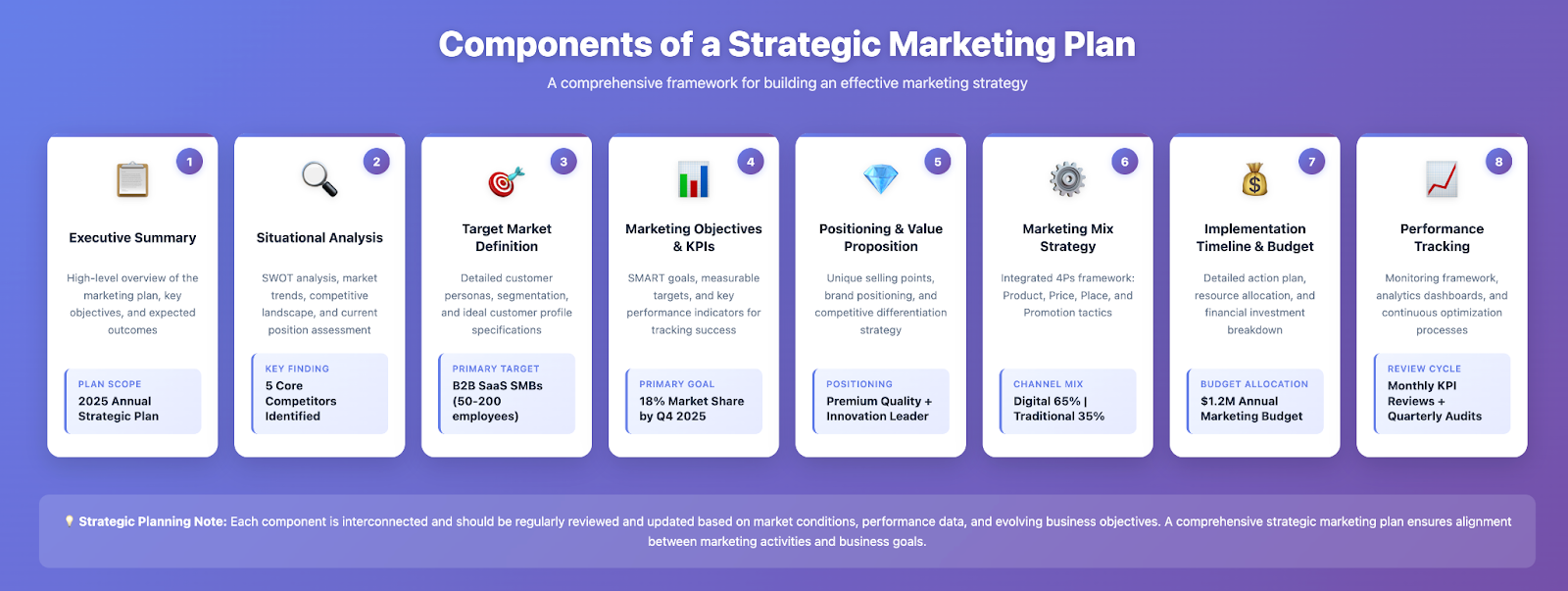Strategic marketing is a comprehensive, long-term approach to aligning marketing efforts with business objectives to gain sustainable competitive advantage in the marketplace. Unlike tactical marketing focused on short-term campaigns, strategic marketing involves systematic market research, target audience segmentation, competitive analysis, and strategic planning that guides all marketing activities toward achieving measurable business goals.
This guide explains the strategic marketing definition, explores the strategic marketing process, provides a strategic marketing plan framework, and shares proven strategic marketing management techniques that help organizations maximize ROI, increase market share, and build lasting customer relationships in 2025.
Key Takeaways:
- Strategic marketing is the process of aligning marketing strategy with business objectives through systematic market research, target audience analysis, and competitive positioning for long-term growth.
- Core components: Market research and analysis, customer segmentation, competitive advantage development, strategic marketing plan creation, and marketing mix optimization (product, price, place, promotion).
- Benefits: Sustainable competitive advantage, better resource allocation, data-driven decision-making, consistent messaging across marketing campaigns, and measurable progress toward business goals.
- Five stages of the strategic marketing process: situational analysis (SWOT), market research, strategy formulation, implementation planning, and performance measurement.
- Best for: Organizations seeking long-term market position strengthening, businesses entering new markets, companies differentiating from competitors, and marketing teams maximizing ROI through strategic planning.
What Is Strategic Marketing?
At its core, strategic marketing answers fundamental business questions:
- Which customer segments should we serve?
- How do we differentiate from competitors?
- What value proposition resonates with our target audience?
- Which markets offer the greatest growth opportunities?
- How should we allocate marketing resources for maximum ROI?
According to the American Marketing Association, strategic marketing focuses on creating value for customers, building sustainable competitive advantage, and achieving organizational objectives through market-oriented strategic planning.
This distinguishes it from tactical marketing, while tactical marketing executes specific campaigns and initiatives, strategic marketing provides the overarching framework that guides what campaigns to run, why they matter, and how they contribute to long-term success.
Strategic Marketing vs Tactical Marketing vs Marketing Strategy
Understanding the distinctions between related concepts clarifies what strategic marketing encompasses.
Sum up: Marketing strategy is one component of strategic marketing, it's the specific plan for achieving marketing objectives derived from the broader strategic marketing framework. Tactical marketing represents the day-to-day execution of that strategy through specific marketing campaigns, content creation, advertising, and promotional activities.
Importance of Strategic Marketing
Organizations that excel at strategic marketing consistently outperform competitors by systematically aligning marketing efforts with business objectives, allocating resources efficiently, and adapting to market changes proactively.
Here's why strategic marketing is essential for sustainable growth.
Sustainable Competitive Advantage
Strategic marketing helps organizations identify and develop sustainable competitive advantage – unique positions in the market that competitors find difficult to replicate. Through systematic competitive analysis, companies discover opportunities to differentiate based on product innovation, superior customer service, brand positioning, pricing strategies, or market segmentation.
Better Resource Allocation and ROI
Without strategic marketing, organizations spread resources across too many initiatives without clear priorities. Strategic marketing provides the framework for allocating budgets, personnel, and time to highest-impact opportunities based on market potential, competitive dynamics, and alignment with business goals.
Strategic marketers use marketing analytics and data-driven decision-making to identify which customer segments generate the highest lifetime value, which channels deliver the best ROI, and which products or services offer the greatest growth potential, ensuring investments flow to initiatives that maximize returns.
Consistent Messaging and Brand Position
Strategic marketing establishes clear brand positioning, value propositions, and messaging frameworks that create consistency across all marketing efforts and customer touchpoints. This consistency builds brand recognition, reinforces competitive differentiation, and creates cohesive customer experiences whether prospects interact via website, social media, advertising, or sales conversations.
Proactive Market Adaptation
Markets evolve, customer needs change, competitors launch new products, technologies disrupt industries, regulations shift. Strategic marketing involves continuous market research and environmental scanning that enables organizations to anticipate changes and adapt proactively rather than reactively scrambling when disruption occurs.
Alignment Across the Organization
Effective strategic marketing aligns marketing with sales, product development, customer service, and operations around shared objectives and target customer understanding. This cross-functional alignment eliminates silos, reduces conflicting priorities, and ensures everyone works toward common business objectives.
The Strategic Marketing Process: 5 Stages
The strategic marketing process is the systematic framework organizations follow to develop and implement strategic marketing plans. While specific methodologies vary, the core process involves five interconnected stages.
Stage 1: Situational Analysis (SWOT Analysis)
Strategic marketing begins with comprehensive situational analysis understanding your organization's current position, market conditions, competitive landscape, and environmental factors. The most common framework is SWOT analysis – evaluating Strengths, Weaknesses, Opportunities, and Threats.
Internal Analysis (Strengths & Weaknesses):
- Strengths: Core competencies, brand equity, technological capabilities, customer relationships, distribution networks, financial resources, talented teams
- Weaknesses: Resource constraints, capability gaps, brand perception issues, operational inefficiencies, limited market presence, customer service problems
External Analysis (Opportunities & Threats):
- Opportunities: Emerging market trends, underserved customer segments, competitor weaknesses, technological innovations, regulatory changes favoring your business, partnership possibilities
- Threats: Competitive pressures, market saturation, economic downturns, changing customer preferences, disruptive technologies, regulatory challenges, supply chain risks
The situational analysis also includes examining the broader macro environment through PESTEL analysis (Political, Economic, Social, Technological, Environmental, Legal factors) that may impact strategic marketing decisions.
Stage 2: Market Research and Customer Analysis
Market research provides the customer insights and market intelligence that inform strategic decisions. This stage involves both quantitative research (surveys, analytics data, market sizing studies) and qualitative research (interviews, focus groups, ethnographic observation).
Key research areas include:
- Target Audience Understanding: Demographics, psychographics, behaviors, needs, pain points, buying processes, decision criteria
- Market Segmentation: Dividing the broader market into distinct customer segments based on shared characteristics, then prioritizing which segments to serve
- Customer Needs Analysis: Understanding what customers value, what problems they need solved, and what outcomes they seek
- Market Size and Growth: Estimating total addressable market, serviceable available market, and growth trends
- Competitive Intelligence: Analyzing competitor offerings, positioning, pricing, strengths/weaknesses, and market share
Effective market research transforms assumptions into validated insights, ensuring strategic marketing decisions are grounded in market realities rather than gut feelings or outdated conventional wisdom.
Stage 3: Strategy Formulation and Positioning
Armed with situational analysis and market research insights, organizations formulate strategic marketing approaches defining how to compete and win in target markets. This stage produces several critical strategic outputs:
- Market Segmentation and Targeting: Select which customer segments to serve based on segment attractiveness (size, growth, profitability) and organizational capabilities to serve them effectively.
- Competitive Positioning: Define how you want to be perceived relative to competitors in customers' minds. Positioning answers: What makes us different? Why should customers choose us? What unique value do we deliver?
- Value Proposition Development: Articulate the specific benefits customers receive from your offerings and how they solve customer problems better than alternatives.
- Strategic Marketing Plan: Document the comprehensive strategic marketing plan including:
- Market and customer analysis summary
- Target segment definitions and prioritization
- Competitive positioning statement
- Marketing objectives and key performance indicators (KPIs)
- Strategic approaches for achieving objectives
- Marketing mix strategy (4Ps: Product, Price, Place, Promotion)
- Resource requirements and budget allocation
- Implementation timeline and milestones
Stage 4: Implementation Planning (Marketing Mix)
Strategy formulation describes what to achieve; implementation planning details how to execute. This stage develops tactical plans across the marketing mix – the 4Ps (or 7Ps for services) that operationalize strategy:
- Product Strategy: What products/services to offer, features and benefits to emphasize, product development priorities, service levels, packaging, branding
- Pricing Strategy: Pricing models, price points, discounting approaches, payment terms – all aligned with positioning (premium, value, penetration pricing)
- Place (Distribution) Strategy: How customers access your offerings – direct sales, retail channels, e-commerce, partnerships, distribution networks
- Promotion Strategy: How to communicate value and reach target audiences – advertising, content marketing, social media, PR, events, email marketing, sales enablement
For service businesses, the extended 7Ps add People (staff and customer service), Process (service delivery), and Physical Evidence (tangible elements of service experiences).
Implementation plans also specify organizational responsibilities, timelines, budgets, and resources required to execute each element of the marketing mix.
Stage 5: Performance Measurement and Optimization
Strategic marketing demands accountability – measuring progress toward objectives and continuously optimizing based on results. This final stage establishes metrics, tracking mechanisms, and review processes.
Key Performance Indicators (KPIs):
- Market Share: Percentage of total market revenue or units sold
- Customer Acquisition Cost (CAC): Cost to acquire new customers
- Customer Lifetime Value (CLV): Total profit expected from customer relationship
- Brand Awareness: Percentage of target audience recognizing brand
- Net Promoter Score (NPS): Customer loyalty and satisfaction measure
- Marketing ROI: Revenue generated relative to marketing investment
- Market Position: Competitive ranking and perception metrics
Strategic marketing reviews occur quarterly or annually, assessing progress, identifying what's working, diagnosing underperformance, and adjusting strategies based on market changes and performance data. This continuous improvement cycle ensures strategic marketing remains relevant and effective as markets evolve.
Creating a Strategic Marketing Plan
A strategic marketing plan is the comprehensive document that captures strategic marketing analysis, decisions, and implementation roadmaps. While format and detail levels vary by organization, effective strategic marketing plans share common components.

Executive Summary
The opening section provides a high-level overview of the strategic marketing plan, summarizing market opportunity, target segments, competitive positioning, key objectives, and resource requirements. This allows executives to quickly grasp the strategic direction without reading the entire document.
Situational Analysis
Comprehensive market context including:
- Current Business Performance: Revenue, market share, customer metrics, recent trends
- SWOT Analysis: Organizational strengths/weaknesses and market opportunities/threats
- Competitive Landscape: Key competitors, their strategies, market positions, strengths/weaknesses
- Market Trends: Customer behavior shifts, technological changes, regulatory developments, economic factors
Target Market Definition
Detailed profiles of priority customer segments:
- Demographic and firmographic characteristics
- Psychographic attributes (values, attitudes, lifestyles)
- Behavioral patterns (buying process, media consumption, brand interactions)
- Needs, pain points, and desired outcomes
- Segment size, growth potential, and profitability
- Rationale for segment prioritization
Marketing Objectives and Goals
Specific, measurable, achievable, relevant, time-bound (SMART) objectives supporting business goals:
- Market share targets (e.g., "Increase market share from 12% to 18% within 24 months")
- Customer acquisition goals (e.g., "Acquire 50,000 new customers in target segment by end of year")
- Revenue objectives (e.g., "Generate $25M in revenue from new product line by Q4")
- Brand awareness targets (e.g., "Achieve 60% aided brand awareness among target audience")
- Customer retention goals (e.g., "Improve customer retention rate from 75% to 85%")
Strategic Positioning and Value Proposition
Clear articulation of how the organization will compete:
- Positioning Statement: Concise description of target customer, category, point of difference, and reason to believe
- Value Proposition: The unique benefits and value customers receive
- Brand Personality: How the brand should be perceived (attributes, voice, tone)
- Differentiation: What makes the offering distinctly better than competitors
Marketing Mix Strategy (4Ps/7Ps)
Detailed strategies across each marketing mix element:
Product Strategy:
- Product portfolio and feature priorities
- New product development roadmap
- Service levels and customer experience standards
- Packaging and branding approach
Pricing Strategy:
- Pricing model and structure
- Price positioning (premium, parity, value)
- Discounting and promotional pricing policies
- Revenue optimization approaches
Distribution (Place) Strategy:
- Channel strategy (direct, indirect, multi-channel)
- Distribution partner selection criteria
- Geographic expansion plans
- E-commerce and digital channel approach
Promotion Strategy:
- Integrated marketing communications plan
- Channel mix (digital, social media, content, advertising, PR, events)
- Messaging framework and key messages by segment
- Campaign themes and creative direction
Implementation Timeline and Budget
Concrete implementation details:
- Quarterly or monthly action plans with specific initiatives
- Responsible parties and organizational structure
- Budget allocation by initiative, channel, and time period
- Key milestones and deliverables
- Dependencies and risk mitigation plans
Metrics and Performance Tracking
How success will be measured:
- Key performance indicators (KPIs) and targets
- Measurement methodology and data sources
- Reporting cadence and dashboard specifications
- Review process and decision criteria for strategy adjustments
Strategic Marketing Management
Strategic marketing management is the organizational discipline of executing strategic marketing processes effectively, encompassing leadership, organizational capabilities, resource management, and continuous improvement practices that ensure strategic marketing plans translate into results.
Leadership and Organizational Structure
Effective strategic marketing requires senior leadership commitment, clear accountability, and organizational structures supporting cross-functional collaboration. Leading organizations appoint Chief Marketing Officers (CMOs) or VPs of Strategic Marketing responsible for:
- Leading strategic marketing planning processes
- Aligning marketing strategy with corporate objectives
- Building market insights capabilities and customer understanding
- Allocating marketing resources and budgets strategically
- Ensuring execution excellence across marketing initiatives
- Measuring and reporting marketing performance to executive leadership
Cross-Functional Collaboration
Strategic marketing success depends on collaboration across multiple functions:
- Sales: Aligning on target customers, value propositions, competitive positioning, and lead generation priorities
- Product: Coordinating on product roadmaps, feature prioritization, market requirements, and go-to-market planning
- Customer Success: Leveraging customer insights, improving retention, and driving expansion revenue
- Finance: Budgeting, ROI analysis, and performance measurement
- Operations: Ensuring delivery capabilities match marketing promises
Marketing Technology and Data Infrastructure
Modern strategic marketing management requires technology enabling marketing attribution, performance tracking, and data-driven decision-making:
- Marketing Analytics Platforms: Unified data and reporting across channels
- Customer Data Platforms (CDP): Centralized customer information for segmentation and personalization
- Marketing Automation: Scalable campaign execution and lead nurturing
- CRM Systems: Customer relationship management and sales enablement
- Business Intelligence Tools: Data visualization and self-service analytics
Talent and Capability Development
Strategic marketing management involves building organizational capabilities through:
- Hiring marketers with strategic thinking, analytical skills, and market research expertise
- Training programs developing strategic planning competencies
- Creating mentorship and knowledge sharing mechanisms
- Building data literacy across marketing teams
- Fostering customer-centric and analytical culture
Agile Strategic Planning
Traditional annual strategic planning cycles are giving way to more agile approaches recognizing market volatility:
- Rolling Forecasts: Updating projections quarterly rather than annual static plans
- Test-and-Learn Culture: Rapid experimentation, measurement, and scaling of what works
- Scenario Planning: Developing multiple strategic scenarios based on different market conditions
- Regular Strategy Reviews: Quarterly assessments of strategic assumptions and performance
Common Strategic Marketing Challenges
Even well-intentioned strategic marketing efforts face obstacles. Recognizing common challenges helps organizations address them proactively.
Insufficient Market Research
Many organizations rush to strategy formulation without investing adequately in market research and customer understanding. This results in strategies based on assumptions rather than validated insights, leading to misaligned positioning, wrong target segment prioritization, or value propositions that don't resonate.
Solution: Commit resources to continuous market research, customer feedback collection, competitive intelligence, and testing strategic assumptions before full-scale implementation.
Disconnect Between Strategy and Execution
Beautiful strategic marketing plans fail when tactical execution doesn't align with strategic direction. This happens when strategic planners lack connection to marketing operations, when communication breaks down, or when day-to-day pressures override strategic priorities.
Solution: Involve tactical marketing teams in strategic planning, create clear implementation plans with specific responsibilities, establish regular check-ins ensuring tactical work advances strategic objectives, and empower teams to question initiatives misaligned with strategy.
Short-Term Focus Undermining Long-Term Strategy
Quarterly earnings pressure, urgent competitive threats, or leadership changes often cause organizations to abandon strategic marketing plans in favor of short-term tactical responses. This reactive approach sacrifices sustainable competitive advantage for temporary gains.
Solution: Secure executive sponsorship for strategic marketing, communicate strategic rationale broadly, track leading and lagging indicators showing strategic progress, and balance short-term tactics with long-term strategic consistency.
Inadequate Resources
Strategic marketing plans often fail when organizations underestimate resource requirements or reallocate budgets and personnel to other priorities, leaving insufficient support for strategy execution.
Solution: Conduct realistic resource planning during strategy development, secure upfront budget commitments, build business cases demonstrating expected ROI, and prioritize strategic initiatives over non-strategic activities.
Failure to Adapt
Markets change, customer preferences evolve, competitors pivot, technologies disrupt, regulations shift. Strategic marketing plans that remain static despite changing conditions become obsolete, yet some organizations cling to outdated strategies due to sunk cost fallacy or change resistance.
Solution: Build flexibility into strategic plans, establish trigger points for strategic reviews, foster organizational agility and learning culture, and view strategic planning as continuous process rather than annual event.
Best Practices for Strategic Marketing Success
Organizations excelling at strategic marketing consistently apply these proven practices:
Start with Customer Understanding
Effective strategic marketing is customer-centric, not product-centric. Begin with a deep understanding of target audience needs, behaviors, and decision processes. Use ethnographic research, customer interviews, journey mapping, and data analysis to build genuine empathy and insight. Test strategic assumptions with real customers before committing resources.
Ground Strategy in Data and Analysis
Move beyond intuition by using data-driven insights for strategic decisions. Leverage marketing ROI analysis, customer analytics, market research, and competitive intelligence. Build hypotheses, test them rigorously, and let evidence guide strategy formulation rather than assumptions or "best practices" from different contexts.
Maintain Strategic Consistency
Consistency amplifies strategic marketing effectiveness. Resist temptation to chase every new trend or pivot messaging frequently. Sustained strategic consistency builds brand recognition, reinforces positioning, and compounds returns over time. Change strategically when market conditions genuinely warrant it, not reactively to temporary fluctuations.
Balance Planning and Agility
Strategic planning provides direction; agility enables adaptation. Develop strategic frameworks rather than rigid scripts. Create principles guiding decisions rather than detailed prescriptions. Empower teams to experiment within strategic guardrails, learn quickly, and scale what works.
Measure What Matters
Define success metrics aligned with strategic objectives, not just easily-measured vanity metrics. Track market share, customer lifetime value, brand perception, and competitive position alongside campaign metrics. Use measurement to inform strategy refinement, not just prove ROI.
Foster Cross-Functional Alignment
Strategic marketing succeeds through organizational alignment. Involve sales, product, customer success, and operations in strategic planning. Share customer insights broadly. Align incentives around shared objectives. Break down silos preventing coordinated customer experiences.
Conclusion
Strategic marketing is what turns scattered marketing efforts into a unified, revenue-focused engine. It defines where the business should compete, how it should position itself, and what long-term value it should deliver to customers.
However, executing a strategy at this level requires more than creative planning, it demands reliable data, unified visibility, and continuous performance alignment across channels. That’s where Improvado comes in.
Improvado empowers marketing and revenue teams to execute strategic marketing with precision by:
- Centralizing cross-channel performance data, bringing insights from paid, organic, CRM, and revenue platforms into one governed analytics layer.
- Ensuring marketing data governance, continuously monitoring campaign pacing, data accuracy, and budget alignment to prevent strategic drift.
- Enabling real-time performance analysis, helping teams evaluate strategic KPIs like ROI, CAC, and customer lifetime value without manual reporting.
- Supporting long-term visibility, connecting historical and current data to track strategic progress and inform resource allocation.
With Improvado, marketing leaders can move beyond surface metrics to understand what’s truly driving growth. The platform provides the analytical foundation needed to align every marketing initiative with overarching business objectives.
See how Improvado can help your organization turn strategic marketing into measurable growth — book a demo today.
.png)




.png)
